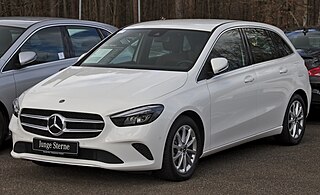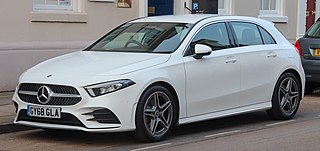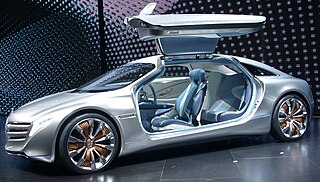
The Mercedes-Benz B-Class is a subcompact executive car manufactured and marketed by Mercedes-Benz since 2005. Based on the A-Class with larger dimensions, the European New Car Assessment Programme classifies it as a small MPV.

The Mercedes-Benz A-Class is a subcompact car produced by the German automobile manufacturer Mercedes-Benz as the brand's entry-level vehicle. The first generation was introduced in 1997, the second generation (W169) in late 2004 and the third generation (W176) in 2012. The fourth generation model (W177), which was launched in 2018, marked the first time the A-Class was offered in the United States and Canada. This fourth generation A-Class is also the first to be offered both as a hatchback (W177) and sedan (V177).

The Mercedes-Benz Citaro is a single-decker, rigid or articulated bus manufactured by Mercedes-Benz/EvoBus. Introduced in 1997, the Citaro is available in a range of configurations, and is in widespread use throughout Europe and parts of Asia, with more than 55,000 produced by December 2019.

The Honda Clarity is a nameplate used by Honda on alternative fuel vehicles. It was initially used only on hydrogen fuel-cell electric vehicles such as the 2008 Honda FCX Clarity, but in 2017 the nameplate was expanded to include the battery-electric Honda Clarity Electric and the plug-in hybrid electric Honda Clarity Plug-in Hybrid, in addition to the next generation Honda Clarity Fuel Cell. Clarity production ended in August 2021 with US leases for the fuel cell variant continuing through to 2022.

The Mercedes-Benz W221 is a chassis code of the fifth generation S-Class produced from August 2005 until June 2013. The S-Class are the flagship vehicles of Mercedes-Benz, and each generation typically introduces a range of technical innovations and developments that, over time will find their way into smaller cars.

The F-Cell is a hydrogen fuel cell electric vehicle developed by Daimler AG. Two different versions are known - the previous version was based on the Mercedes-Benz A-Class, and the new model is based on the Mercedes-Benz B-Class. The first generation F-Cell was introduced in 2002, and had a range of 100 mi (161 km), with a top speed of 82 mph (132 km/h). The current B-Class F-CELL has a more powerful electric motor rated at 100 kW (134 hp), and a range of about 250 mi (402 km). This improvement in range is due in part to the B-Class's greater space for holding tanks of compressed hydrogen, higher storage pressure, as well as fuel cell technology advances. Both cars have made use of a "sandwich" design concept, aimed at maximizing room for both passengers and the propulsion components. The fuel cell is a proton exchange membrane fuel cell (PEMFC), designed by the Automotive Fuel Cell Cooperation (AFCC) Corporation.
Hydrogen technologies are technologies that relate to the production and use of hydrogen as a part hydrogen economy. Hydrogen technologies are applicable for many uses.

The Mercedes-Benz Vito is a mid-sized light commercial vehicle (LCV) produced by Mercedes-Benz, available as a panel van, chassis cab, or multi-purpose vehicle (MPV), carrying cargo or up to eight passengers. In the Mercedes-Benz van lineup, it is positioned between the larger Sprinter and the smaller Citan.

A fuel cell bus is a bus that uses a hydrogen fuel cell as its power source for electrically driven wheels, sometimes augmented in a hybrid fashion with batteries or a supercapacitor. The only emission from the bus is water. Several cities around the world have trialled and tested fuel cell buses, with over 5,600 buses in use worldwide, the majority of which are in China.
Mercedes-Benz, commonly referred to as Mercedes and sometimes as Benz, is a German luxury and commercial vehicle automotive brand established in 1926. Mercedes-Benz AG is headquartered in Stuttgart, Baden-Württemberg, Germany. Mercedes-Benz AG produces consumer luxury vehicles and light commercial vehicles badged as Mercedes-Benz. From November 2019 onwards, Mercedes-Benz-badged heavy commercial vehicles are managed by Daimler Truck, a former part of the Mercedes-Benz Group turned into an independent company in late 2021. In 2018, Mercedes-Benz was the largest brand of premium vehicles in the world, having sold 2.31 million passenger cars.

The Mercedes-Benz SLS AMG is a front mid-engine, 2-seater, limited production grand tourer developed by the Mercedes-AMG division of German automotive manufacturer Mercedes-Benz, with the assistance of David Coulthard. The car is the successor to the Mercedes-Benz SLR McLaren and was described by Mercedes-Benz as a spiritual successor to the Mercedes-Benz 300SL Gullwing, mainly because it was inspired by the latter. SLS stands for "Super Leicht Sport".
Smart is a German automotive marque. Smart Automobile Co., Ltd. is a joint venture established by Mercedes-Benz AG and Zhejiang Geely Holding Group in 2019 and aimed at producing Smart-badged cars in China to be marketed globally. The venture is headquartered in Ningbo. It produces small battery electric vehicles in their manufacturing plant in China, while previously the marque was known to produce microcars and subcompacts, primarily the Fortwo and Forfour, at Smartville in Hambach, Moselle, France and in the Revoz plant. Its distribution, marketing and aftersales activities in Europe are currently handled by smart Europe GmbH which is headquartered in Stuttgart, Germany.

A range extender is a fuel-based auxiliary power unit (APU) that extends the range of a battery electric vehicle by driving an electric generator that charges the vehicle's battery. This arrangement is known as a series hybrid drivetrain. The most commonly used range extenders are internal combustion engines, but fuel-cells or other engine types can be used.

The Mercedes-Benz F800 Style is a concept car made by the German brand Mercedes-Benz and first shown at the 2010 Geneva Motor Show. It was a preview to the second generation Mercedes-Benz CLS.

The Mercedes-Benz F125 is an electrically driven, hydrogen fuel cell concept car unveiled at the 2011 Frankfurt Motor Show. It is named 125 to celebrate the 125th anniversary of Mercedes-Benz.

The Mercedes-Benz W222 is the sixth generation of the S-Class produced from 2013 to 2020, the successor of the W221 S-Class and the predecessor of the W223 S-Class. The W222 was designed during 2009. The original design proposal of the car was created by Il-hun Yoon, a Korean designer, who was inspired by the Mercedes-Benz F700 concept car. The exterior design was developed by a team of designers under the direction of Robert Lešnik. The W222 has a similar design theme to the C-Class (W205) and E-Class (W213).

Mercedes-EQ is a series of battery electric vehicles manufactured by Mercedes-Benz. The first model was previewed at the Paris Motor Show in 2016 with the Generation EQ concept vehicle. Mercedes-Benz intends to produce ten EQ models by 2022, three of which will have the Smart brand, representing between 15% and 25% of the company's global sales. All of Mercedes-Benz electric vehicle design and production efforts will target the EQ family.

W246 is the internal designation for the second generation Mercedes-Benz B-Class, which is a range of 5-door hatchbacks produced by German luxury manufacturer Daimler AG under the Mercedes-Benz brand from late 2011 to late 2018. Introduced at the 2011 International Motor Show Germany as a subcompact executive car, models years for the W246 started at 2012 and ranged to 2019. European models went on sale in November 2011. Japanese and Australian models went on sale in April 2012, and Canadian models in late 2012 as the 2013 model year. They are assembled at Rastatt, Germany, and from 2011 at Kecskemét, Hungary. By summer 2013, over 230,000 second generation B-Class cars had been delivered.

The Hyundai Vision FK is a concept car that uses a plug-in hybrid drivetrain with both a large traction battery and a hydrogen fuel cell; the concept vehicle was developed by Hyundai and Rimac Automobili. The mid-motor, rear-wheel-drive sports coupe was unveiled at the Hydrogen Wave Forum in September 2021, an event organized by Hyundai to outline its plans to popularize hydrogen vehicles by 2040 for "Everyone, Everything and Everywhere". Power is delivered through two electric traction motors, both on the rear axle. The Vision FK can be plugged in to recharge its traction battery, which has more than 60 kW-hr of energy storage capacity, and the onboard fuel cell affords it a range greater than 600 km (370 mi).

















